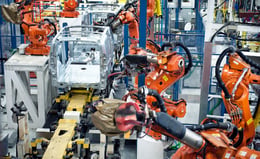The Key Elements of Effective Supply Chain Leadership
Nick Ostdick - May 25, 2017

We’ve discussed at great length on this blog the importance of deploying the right technological platforms and strategic planning initiatives in order to leverage the most effective models for global supply chain management. Concepts like Industry 4.0, advanced analytics, and S&OE (sales and operations execution) are critical elements to efficient production and planning sequences, however, at the end of the day, supply chain management is just as much about the people behind the technology and strategy as it is the technology and strategy itself.
In the past, we’ve boiled supply chain management down to the ability to put the right products in front of the right people at the right time. Though we’ve discussed the qualities of the right products and the right time, we haven’t dedicated much of the discussion to examining the qualities, skills, and abilities required of the individuals who administer these production and supply streams.
This of course begs the question: What are the essential qualities supply chain planners and managers must have in order to successfully oversee variant-rich, complex manufacturing networks? What skills must these individuals leverage in order to promote growth and productivity within a given manufacturing organization? With this in mind, let’s examine the key elements of effective supply chain leadership and how planners and managers can best exemplify these traits.
Knowledge and understanding of technology
Yes, as we just discussed, effective supply chain management is really about the people administering the logistics that drive the production and supply pipeline. In order to effectively manage the supply stream, planners and managers must have a functional understanding and knowledge about the technology platforms that enhance their supply networks. Whether it’s selecting an ERP system, deploying advanced analytics for more accurate planning and production, or implementing an integrated container management solution, planners and managers must realize the value propositions of these technologies in relation to the needs and demands of their organizations. Point being: It’s not simply enough to know how a software system functions, but rather how a system works given the restraints, challenges, or opportunities within a given supply chain model.
Flexibility
Instability is part and parcel of today’s global manufacturing. Complex partner networks, variant-rich production cycles, and a wide range of customer needs and demands mean planners and managers must be flexible and agile in order to respond to ever-changing constraints and parameters. Ensuring the right products in the right volume in the right condition arrive at the right time at the right location means planners and managers must be able to respond to alterations in planning and productions schemes without creating bottlenecks or disruptions in production programs. In addition, flexibility and the ability to nimbly respond to changes in planning and production sequences often results in innovation. Planners and managers who can react to unforeseen supply complications can discover new methods of administering supply chains which may contain previously unknown value propositions for companies and supply networks.
Project management capability
Overseeing a manufacturing company’s supply stream in the 21st Century essentially requires planners and managers to simultaneously complete multiple tasks at once. Everything from strategic demand capacity planning to transportation management means supply chain leaders, successful supply chain administrators must have a number of critical skills, including:
- The ability to negotiate budgets, resources, raw materials, scheduling, and personnel management.
- A high degree of personal organization and the ability to prioritize certain tasks over others given a number of situations and contexts.
- A proactive approach to risk management in terms of resource management, job allocation, and combatting potential supply stream disruption.
These qualities should be top priority for manufacturing companies when assessing the needs of their supply chain logistics and how those who oversee these logistics function within a larger, company-wide context.
The Three C’s
Communication. Collaboration. Change. The three C’s of supply chain management and logistics are critical drivers for a manufacturing company’s success or failure in terms of their supply chain efficacy, but also for the planners and managers who oversee and deploy a company’s supply chain strategy.
Communication: First and foremost, planners and managers must be able to clearly articulate production benchmarks and goals, but they must also be able to distribute vital information, data, and reporting about the methods by which companies can achieve these benchmarks and the obstacles standing in the way of meeting these goals. In addition, planners and managers must be able to breakdown communication and planning silos to include more individuals and departments across the value chain in the planning process.
Collaboration: As we’ve discussed in previous entries, collaboration between various touch points across the value chain is a core driver in creating a cross-organizational platform for sharing supply chain insights and fostering innovation and the development of new and existing operational models or methods. Supply chain leaders must make collaboration a core element of their operational philosophy in order to leverage competitive advantages over rival manufacturing companies.
Change: Disruptions, alterations, variations. These markers of instability are everyday elements in operating a global supply pipeline. But change can also mean turnover in personnel, variances in availability of raw materials, access to adequate facilities or production sites, or any number of other physical aspects of supply chain management. Successful supply chain leaders are not only able to respond to these changes, but they also work to plan for them by creating comprehensive safety nets to address the types of changes that could significantly impact production and supply logistics.
If you want to learn more get your Guide to Industry 4.0:
LATEST POSTS
- Understand Circular Economy in The Manufacturing Industry
- How Can Industry 4.0 IT Integration Be Achieved Smoothly?
- The Significance of Order Sequencing in Discrete Manufacturing
- How to improve your Supply Chain Management: The Power of Control Towers
- Optimizing Human Resource Scheduling in Manufacturing: A Technological Approach



